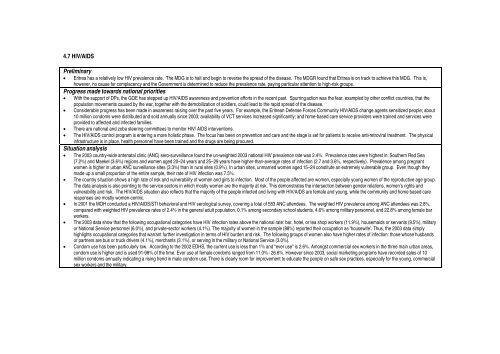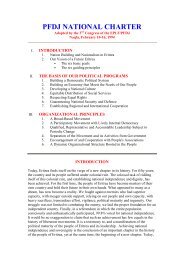Common Country Assessment (CCA) - ECSS | Eritrean Center for ...
Common Country Assessment (CCA) - ECSS | Eritrean Center for ...
Common Country Assessment (CCA) - ECSS | Eritrean Center for ...
Create successful ePaper yourself
Turn your PDF publications into a flip-book with our unique Google optimized e-Paper software.
4.7 HIV/AIDS<br />
Preliminary<br />
• Eritrea has a relatively low HIV prevalence rate. The MDG is to halt and begin to reverse the spread of the disease. The MDGR found that Eritrea is on track to achieve this MDG. This is,<br />
however, no cause <strong>for</strong> complacency and the Government is determined to reduce the prevalence rate, paying particular attention to high-risk groups.<br />
Progress made towards national priorities<br />
• With the support of DPs, the GOE has stepped up HIV/AIDS awareness and prevention ef<strong>for</strong>ts in the recent past. Spurring action was the fear, exampled by other conflict countries, that the<br />
population movements caused by the war, together with the demobilization of soldiers, could lead to the rapid spread of the disease.<br />
• Considerable progress has been made in awareness raising over the past five years. For example, the <strong>Eritrean</strong> Defense Forces Community HIV/AIDS change agents sensitized people; about<br />
10 million condoms were distributed and sold annually since 2003; availability of VCT services increased significantly; and home-based care service providers were trained and services were<br />
provided to affected and infected families.<br />
• There are national and zoba steering committees to monitor HIV/ AIDS interventions.<br />
• The HIV/AIDS control program is entering a more holistic phase. The focus has been on prevention and care and the stage is set <strong>for</strong> patients to receive anti-retroviral treatment. The physical<br />
infrastructure is in place, health personnel have been trained and the drugs are being procured.<br />
Situation analysis<br />
• The 2003 country-wide antenatal clinic (ANC) sero-surveillance found the un-weighted 2003 national HIV prevalence rate was 2.4%. Prevalence rates were highest in: Southern Red Sea<br />
(7.2%) and Maekel (3.6%) regions and women aged 20–24 years and 25–29 years have higher-than-average rates of infection (2.7 and 3.6%, respectively). Prevalence among pregnant<br />
women is higher in urban ANC surveillance sites (3.3%) than in rural sites (0.9%). In urban sites, unmarried women aged 15–24 constitute an extremely vulnerable group. Even though they<br />
made up a small proportion of the entire sample, their rate of HIV infection was 7.5%.<br />
• The country situation shows a high rate of risk and vulnerability of women and girls to infection. Most of the people affected are women, especially young women of the reproductive age group.<br />
The data analysis is also pointing to the service sectors in which mostly women are the majority at risk. This demonstrates the intersection between gender relations, women’s rights and<br />
vulnerability and risk. The HIV/AIDS situation also reflects that the majority of the people infected and living with HIV/AIDS are female and young, while the community and home based care<br />
responses are mostly women-centric.<br />
• In 2001 the MOH conducted a HIV/AIDS/STI behavioral and HIV serological survey, covering a total of 583 ANC attendees. The weighted HIV prevalence among ANC attendees was 2.8%,<br />
compared with weighted HIV prevalence rates of 2.4% in the general adult population, 0.1% among secondary school students, 4.6% among military personnel, and 22.8% among female bar<br />
workers.<br />
• The 2003 data show that the following occupational categories have HIV infection rates above the national rate: bar, hotel, or tea shop workers (11.9%), housemaids or servants (9.5%), military<br />
or National Service personnel (6.0%), and private-sector workers (4.1%). The majority of women in the sample (88%) reported their occupation as ‘housewife’. Thus, the 2003 data simply<br />
highlights occupational categories that warrant further investigation in terms of HIV burden and risk. The following groups of women also have higher rates of infection: those whose husbands<br />
or partners are bus or truck drivers (4.1%), merchants (3.1%), or serving in the military or National Service (3.0%).<br />
• Condom use has been particularly low. According to the 2002 EDHS, the current use is less than 1% and “ever use” is 2.6%. Amongst commercial sex workers in the three main urban areas,<br />
condom use is higher and is used 91-98% of the time. Ever use of female condoms ranged from 11.0% - 26.6%. However since 2003, social marketing programs have recorded sales of 10<br />
million condoms annually indicating a rising trend in male condom use. There is clearly room <strong>for</strong> improvement to educate the people on safe sex practices, especially <strong>for</strong> the young, commercial<br />
sex workers and the military.





